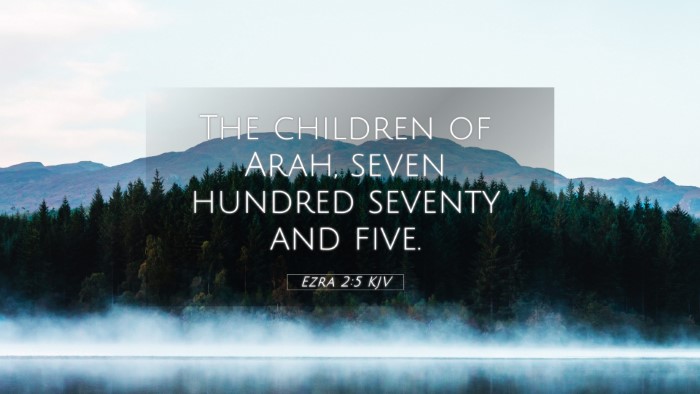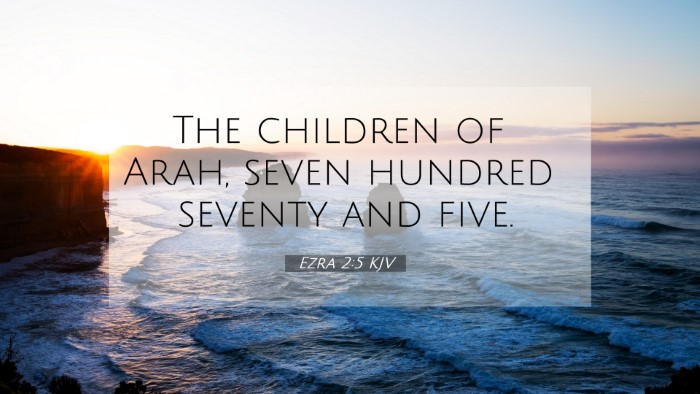Understanding Ezra 2:5
Ezra 2:5 reads: "The children of Shephatiah, three hundred seventy and two." This verse is part of a larger genealogical record in the book of Ezra, detailing the return of the exiles to Jerusalem after the Babylonian captivity. The list not only showcases the numbers of those returning but also emphasizes the importance of lineage and community in the Hebrew tradition.
Overview of Ezra 2:5
This passage contributes to the historical context of the Jewish people during the post-exilic period. It reveals the names and numbers of various families that returned to their homeland, which highlights the restoration of Israel as a nation.
Commentary Insights
Matthew Henry's Commentary
Matthew Henry suggests that the mention of the children of Shephatiah, along with their specific number, underscores God's faithfulness in preserving His people. The name "Shephatiah" itself may signify "God has judged," indicating the recognition of divine authority in the group's return.
Albert Barnes' Commentary
Albert Barnes points out the significance of numbers in this context, indicating that each family represents a remnant of God's chosen people. He emphasizes that these genealogies not only serve a historical purpose but also underline the fulfillment of God's promises to Israel.
Adam Clarke's Commentary
Adam Clarke elaborates on the historical significance of the returnees, interpreting the mention of various clans as a way to reinforce national identity and continuity within the Jewish faith. He suggests that the specifics of these genealogies were essential for maintaining the cultural and religious heritage of the returning exiles.
Thematic Connections and Cross-References
Ezra 2:5 illustrates various themes in Scripture, notably the importance of heritage and God's covenant with Israel. Here are some key cross-references:
- Nehemiah 7:10 - Lists the families that returned to Jerusalem, further enhancing the genealogical record.
- 1 Chronicles 3:17-24 - Offers additional insights into the lineage and heritage of the Israelites.
- Ezra 1:5 - Describes the initiation of the return to Jerusalem, highlighting the divine influence on the exiles' journey.
- Jeremiah 29:10-14 - Prophecies concerning the return of the exiled Israelites and God's plans for them.
- Psalm 126:1-6 - Expresses joy and hope in the restoration of Zion, reflecting on the emotional aspect of returning.
- Isaiah 44:28 - References God’s chosen servant, Cyrus, who facilitated the return of the Jews.
- Ezekiel 37:21-22 - Talks about the unification of Israel and Judah, relevant to the restoration theme.
Inter-Biblical Dialogue
The genealogical records in Ezra allow for comparative Bible verse analysis with other books of Scripture, such as Nehemiah and 1 Chronicles. By identifying these connections, one can gain a deeper understanding of the continuity of God's plan for His people throughout the Bible.
Conclusion
Ezra 2:5 serves as a crucial link in the narrative of Israel's restoration, revealing how God preserves His people across generations. The insights gleaned from public domain commentaries enrich our understanding of this verse and highlight its significance in the broader biblical narrative.




